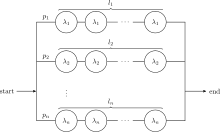Hyper-Erlang distribution

Diagram showing queueing system equivalent of a hyper-Erlang distribution
In probability theory, a hyper-Erlang distribution is a continuous probability distribution which takes a particular Erlang distribution Ei with probability pi. A hyper-Erlang distributed random variable X has probability density function given by
where each pi > 0 with the pi summing to 1 and each of the Eli being an Erlang distribution with li stages each of which has parameter λi.[1][2][3]
See also
References
- ↑ Bocharov, P. P.; D'Apice, C.; Pechinkin, A. V. (2003). "2. Defining parameters of queueing systems". Queueing Theory. doi:10.1515/9783110936025.61. ISBN 9783110936025.
- ↑ Yuguang Fang; Chlamtac, I. (1999). "Teletraffic analysis and mobility modeling of PCS networks". IEEE Transactions on Communications. 47 (7): 1062. doi:10.1109/26.774856.
- ↑ Fang, Y. (2001). "Hyper-Erlang Distribution Model and its Application in Wireless Mobile Networks". Wireless Networks. Kluwer Academic Publishers. 7 (3): 211–219. doi:10.1023/A:1016617904269.
This article is issued from Wikipedia - version of the 9/3/2015. The text is available under the Creative Commons Attribution/Share Alike but additional terms may apply for the media files.